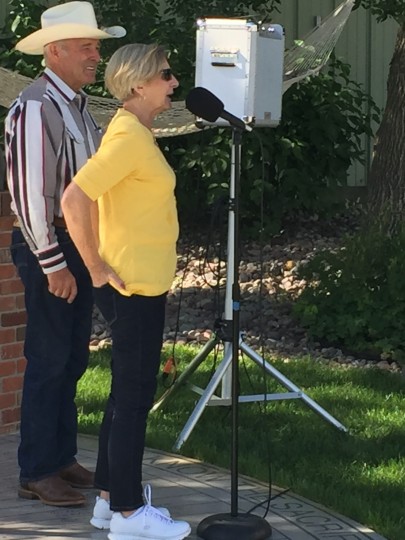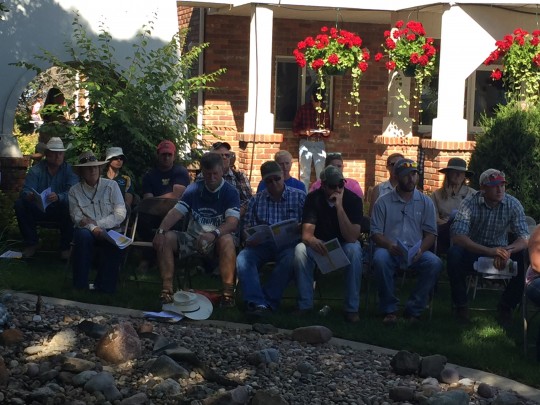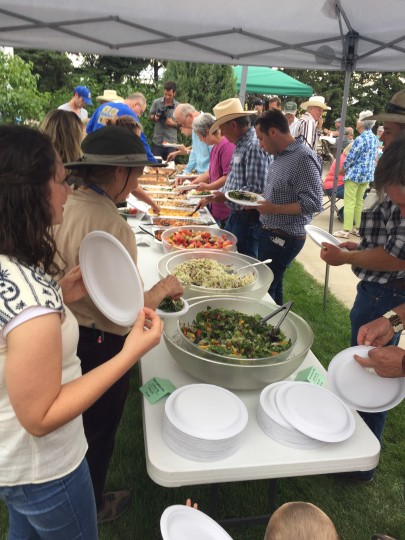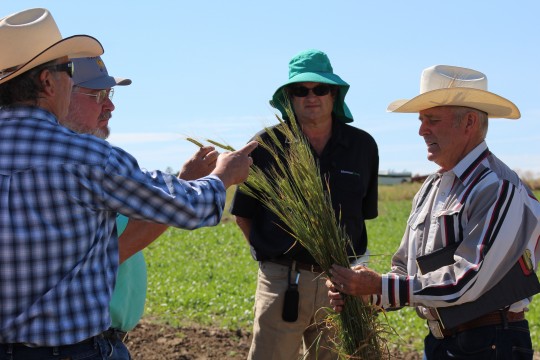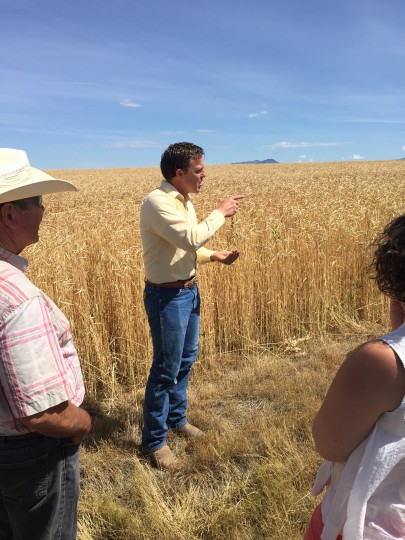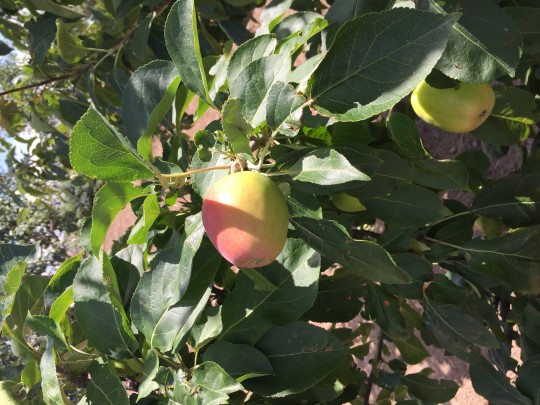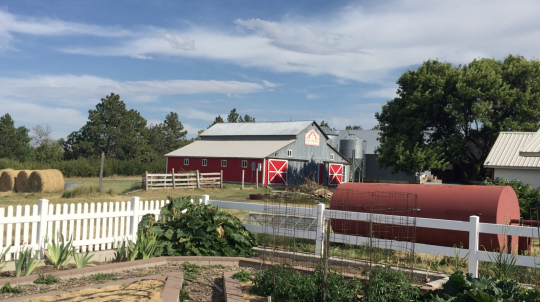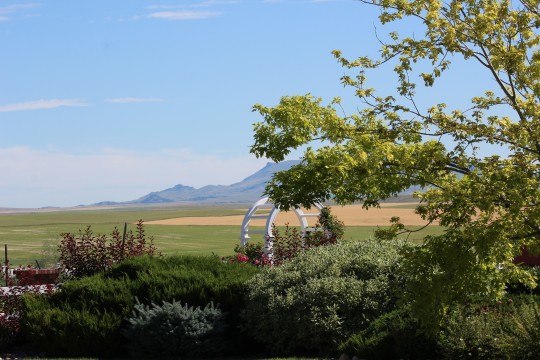It was our great pleasure to be invited to spend an amazing day on July 9th, at the Quinn Farm & Ranch in the beautiful northern Montana prairie. Big Sandy was our destination, and we set out on a dazzlingly sunny day with the bright blue sky stretched out as far as the eye could see—Big Sky Country is very aptly named. Bob Quinn and his team had put together a diverse itinerary so we could all learn more about the benefits of regenerative organic agriculture.
The day began with a warm Montana welcome where Bob introduced some special guests and outlined the day’s activities. There were four main tours punctuated by a delicious lunch of fresh salads topped with crunchy Kracklin’ Kamut® (a healthy snack with only three ingredients: KAMUT® berries, safflower oil and sea salt) and pulled pork on a KAMUT® grain bun.
Bob always refers to his farm as his laboratory and it’s easy to see why. His drive to see organic agriculture grow and thrive is relentless and his generosity in sharing his hard earned knowledge knows no bounds. So our intrepid team set about the tours, as prepared as city dwellers can be, for a day on the farm! Luckily we didn’t have to walk all 5,000+ acres, but we did come away with a new respect for the hard work and dedication of those who grow our food.
TOURS:
1. Experimental Wheat Plots
This experimental wheat project is designed to find the highest quality, anti-inflammatory spring and winter wheat to be grown on the Montana prairie. They are looking for wheat high in nutrition, high yielding, good for baking and have good agronomic characteristics as well as being naturally resistant to pests and disease. The project has five components:
i. Wild Winter Wheat from Turkey (29 plots)
In 2013 they started with 100 types (32 seeds each) from the small grain collection in Idaho. In 2014, 68 were eliminated because they would not stand and in 2015, three more were eliminated because of poor yield. Now, in 2016, 29 remain and are being tested for standing, yield, thrashing, anti-oxidant capacity, protein and mineral content, and electrophoresis. Those with weak straw will also be eliminated.
ii. Modern Winter Wheat Crosses (12 plots)
These test plots are to develop a modern wheat population of high baking quality. In 2009 they crossed 8 different lines
(8=28+8 parents =36). In 2013 they began selecting the best for baking tests and are now down to 14 this year (12 crosses and 2 parents).
iii. Ancient Wheat Collection (4 plots)
This includes Spelt, KAMUT® korasan, Einkorn and Emmer.
iv. Heritage Wheat Collection Winter Wheat (6 plots), Spring Wheat (2 plots)
These test plots are a comparison between ancient, heritage and modern wheat varieties.
v. Modern Wheat Collection Winter Wheat (11 plots), Spring Wheat (3 plots)
Released since WW11 these are being compared to all the others.
One of the main principles of organic farming is diversity. Over the years, the Quinn Farm & Ranch has developed a nine-year crop rotation—most crop rotations are four years. The rotation schedule is constantly evolving with plans to plant a 50/50 fall seeded/spring seeded rotation to maintain diversity while reducing risks.
The goal for any farmer is to grow a high-quality crop in a way that is profitable. For organic farming to be successful, it relies on soil building crops and crop rotations to create diversity, which supports the whole system. The challenges of weed management, soil fertility, insects and disease in organic agriculture are the same as they are in conventional farming, but rather than depend on expensive chemicals, organic farmers have to find alternative ways to deal with these issues.
3.Prairie Orchard & Dry Land Vegetables
The prairie orchard is a testament to perseverance! Many fruits are grown here that have been impossible to grow on the northern great plains. The first trees were planted in 2006 and the main goal was to create a micro-climate. There are barriers against the wind including a mature shelter belt on the West, with spruce trees on the other three sides within the orchard, a snow fence and berry bushes around the perimeter. The orchard is irrigated, but generally this is only used for two uses after transplanting and in drought conditions as needed. Weed control is very important in any type of dry land farming, especially in regards to water: the fewer weeds to consume water the better.
Apples, plums, pears, apricots, cherries, peaches and raspberries are grown in the orchard. Just outside the orchard fence vegetables including summer squash, winter squash, pumpkins, potatoes, Indian corn and sunflowers are grown in abundance.
4.The Oil Barn®:
It began with a desire to become independent and self-sufficient with the idea of creating biodiesel instead of using petroleum. Due to complications another route was pursued, that of providing restaurants with high quality vegetable oil and using the resulting waste to fuel farm equipment. Now by growing safflower and crushing the seeds (the crushers run day and night) and filtering the high-oleic safflower oil, this quality oil in now turning into a viable, sustainable business and another source of revenue for the farm.
The day concluded with a fabulous supper of KAMUT® crust pizzas, fresh salads and KAMUT® pastas. Everyone was then treated to a talent show with members of the Quinn family, friends and locals participating with enthusiastic support from the audience!
We felt privileged to have a glimpse into the daily life on a thriving organic farm.
 Food
Food Farmers
Farmers Sustainable Living
Sustainable Living Living Planet
Living Planet News
News

